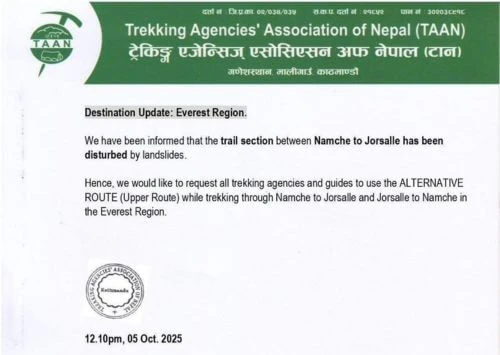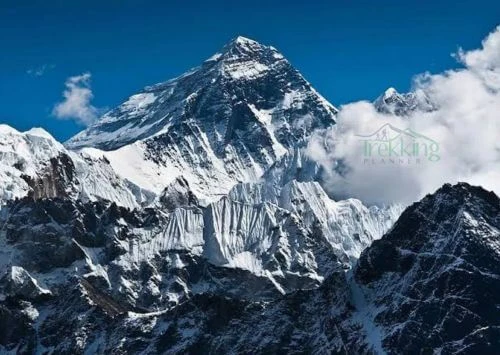The Everest Base Camp Trek is one of the world's most breathtaking adventures, leading travelers through the marvelous Khumbu region of Nepal. The Everest Base Camp lies at the base of the tallest mountain in the world, Mt Everest (8,848.86 meters). Everest Base Camp opens the door to tourism, where thousands of tourists from all around the world visit the ultimate trekking destination. The Everest Base Camp Trek is one of Nepal's classic treks, taking trekkers to an altitude of 5,364 meters.
Trekkers get the opportunity to view the highest mountain in the world, along with other snow-capped mountains, including Nuptse, Lhotse, Ama Dablam, Cho Oyu, Pumori, Thamserku, and others. Similarly, the trek combines walking in dramatic landscapes, ancient Sherpa villages, Buddhist-influenced cultural regions, and allows for viewing exotic wildlife. Trekkers can follow the footsteps of legendary climbers Sir Edmund Hillary and Tenzing Norgay Sherpa, the first to summit Everest.
Beyond the landscape, trekkers can immerse themselves in Sherpa culture, Buddhist traditions, and warm hospitality, offering a unique approach to the trek. The trek is among the top items on the bucket list of adventure enthusiasts, especially those who wish to make a name in the field of trekking. Imagine being able to share your story of reaching the base of the world's highest mountain. The fluttering prayer flags, yak caravans, glacier fields, suspension bridges, mani walls, and stupas welcome trekkers along the route, unlike anywhere else on Earth. The challenge and accessibility bring new scenery, new elevation, and a growing sense of achievement. It is truly the test of human physical and mental limits, making it one of the most celebrated trekking experiences in the world.
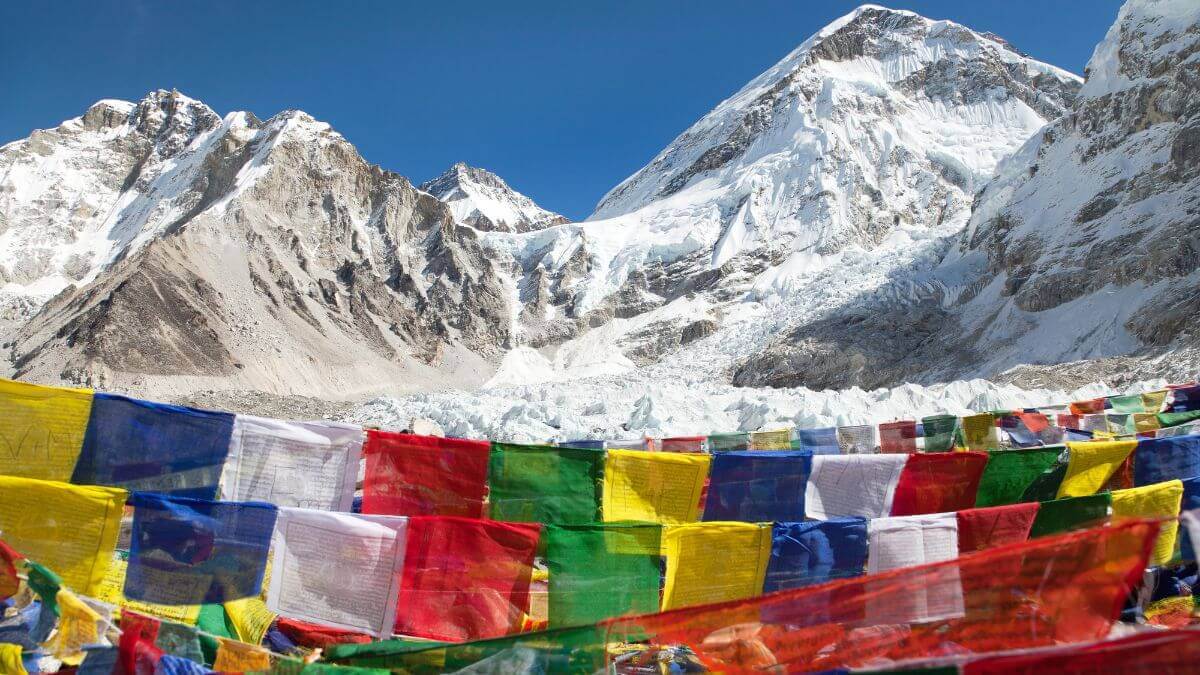
The Everest Base Camp Trekking guide provides an overview of the trekking itinerary, best time to visit, physical preparation, difficulty, altitude and acclimatization, route options, food and accommodation, packing essentials, permit information, cost, and travel insurance requirements. With the detailed guide, trekkers receive practical tips for trekking independently or with a guide or porter. From this blog, you will learn how to prepare for and undertake the journey safely.
Join Nepal Trekking Planner on your journey to the most famous base camp in the world.
Everest Base Camp Trek Itinerary: Day-by-Day Breakdown
The trekking route to Everest Base Camp starts with a scenic flight from Kathmandu or Ramechhap to Lukla. From Lukla, trekkers officially begin the trek, passing through numerous traditional villages such as Phakding, Namche, Tengboche, Dingboche, Lobuche, and Gorakshep. From Gorakshep, trekkers head towards Everest Base Camp and Kalapatthar. Then, for the return journey, trekkers descend to Pheriche, Namche Bazaar, and Lukla before taking a flight back to Kathmandu.
The Everest Base Camp 14 Days Trek itinerary with Nepal Trekking Planner is as follows:
- Day 1: Arrival in Kathmandu and trip preparation, (1,350m/4,429ft), about a 20-25-minute drive from the airport
- Day 2: Take a morning flight from Kathmandu to Lukla (2,860m/9,383ft), 35 min, and trek to Phakding (2,610m/8,560ft), 4-hour trek, walking distance 7.5 km/4.6 miles, and Total Elevation Gain 230 m/ 755 ft
- Day 3: Trek to Namche Bazaar (3,440m/11,287ft) 5-6 hrs. walk, walking Distance: 12 km / 7.45 miles, and Total Elevation Gain 830 m/ 2723 ft
- Day 4: Rest day at Namche Bazaar for acclimatization and local excursion, Hike to Everest View Hotel 3880 m/12730 ft and Total Elevation Gain 440 m/ 1444 ft
- Day 5: Trek to Tengboche (3,850m/12,632ft) 4-5 hrs. walk, walking Distance: 10 km / 6.21 miles, and Total Elevation Gain 420 m/ 1378 ft
- Day 6: Trek to Dingboche (4,350m/14,272ft) 4-5 hrs. walk, walking Distance: 12 km / 7.45 miles, and Total Elevation Gain 550 m/ 1805 ft
- Day 7: Rest day at Dingboche for acclimatization and excursion, Hike to Nangkartshang Peak 5083 m/16677 ft and Total Elevation Gain 673 m/ 2208 ft
- Day 8: Trek to Lobuche (4,910m/16,109ft) 4-5 hrs. walk, walking Distance: 12 km / 7.45 miles, and Total Elevation Gain 500 m/ 1640 ft
- Day 9: Trek to Gorakshep (5,180m/16,995ft) 3-4 hrs. walk and Everest Base Camp (5,364m/17,598ft) 2-3 hrs. walk, walking Distance: 15 km / 9.32 miles and Total Elevation Gain 475 m/ 1489 ft
- Day 10: Hike to Kalapatthar (5,545 m/ 18,192 ft.) and continue trekking to Pheriche (4,371 m /14,340 ft), 5-hour trek, walking Distance: 13 km /8.07 miles, and Total Elevation Gain: 415 m + 810 m/ 1362 ft + 2655ft
- Day 11: Trek from Pheriche to Namche Bazaar (3,440 m/11,286 ft) 6-hour trek, walking Distance: 14 km /8.69 miles, and Total Elevation Gain 800 m/2625 ft
- Day 12: Trek from Namche Bazaar to Lukla (2,828m/9,279ft) 6-hour trek, walking Distance: 21 km /13.0488 miles, and Total Elevation Gain: 612 m/2008 ft
- Day 13: Morning flight from Lukla to Kathmandu
- Day 14: Transfer to the airport and fly back home
Perfect Time to Trek Everest Base Camp
Every season in Nepal offers a different experience on the Everest Base Camp Trek. But the best season for trekking to Everest Base Camp are spring and autumn, as these seasons offer stable weather and comfortable walking conditions.
Spring (March-May)
Spring in Nepal lasts from March to May and is marked by blooming rhododendrons. It is one of the best seasons for trekking to Everest Base Camp, offering clear weather and moderate temperatures. Daytime during spring is generally warm, and nights are cool. The lower regions, especially Lukla and Namche Bazaar, have temperatures around 10 degrees Celsius. In contrast, at higher altitudes, such as Everest Base Camp, temperatures range from -5 to 5 degrees Celsius.
During spring, the landscape is filled with rhododendrons and other alpine flowers in full bloom. The valleys are lush and lively, making it an excellent time for exploration and photography.
Spring is one of the magical times to trek to Everest Base Camp, when the weather gradually becomes warm, from cold mornings to mild afternoons and chilly nights. Due to pleasant weather, it is easier to trek comfortably even at higher altitudes. The landscape itself transforms after the winter snow begins to melt. The rhododendron forest brings the landscape to life, creating an almost dreamlike scene. So, those who want to enjoy the Himalayas at their most colorful can trek to EBC during spring.
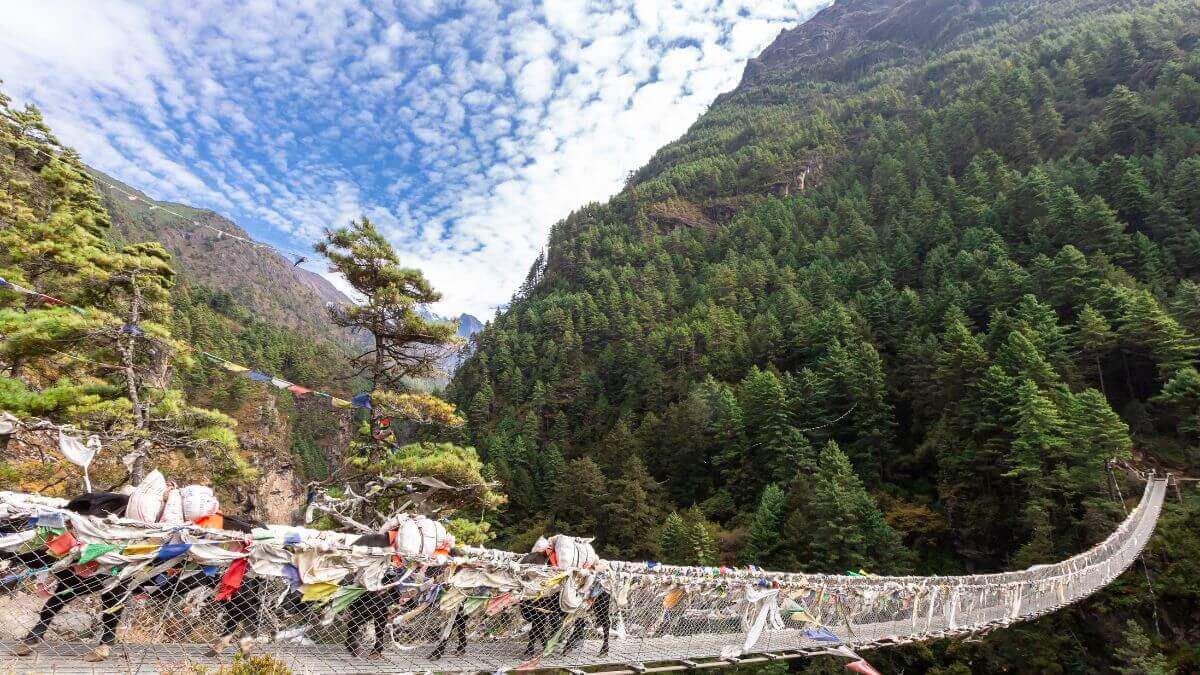
Autumn (September–November)
Autumn in Nepal lasts from September to November, which is another of the best seasons to visit Nepal. The autumn season is marked by stable weather conditions with moderate temperatures. The weather conditions are not extreme, thereby providing a comfortable walking environment. From September to November, the monsoon ends, leaving the atmosphere rain-washed and the views clear and razor-sharp. The weather is stable, with ideal trekking conditions from Lukla to Kalapatthar. The pleasant weather provides a stable, sunny climate with plenty of daylight. The autumn landscape glows with a golden hue, with terraced fields, running rivers, and snow-white mountains under a deep blue sky.
Everest Base Camp Autumn trek feels calm, pure, and rewarding. Major festivals like Dashain and Tihar fall during the autumn season, so trekkers get a chance to experience these festivals firsthand. One can even participate in the festive vibe and immerse oneself in Nepalese hospitality and culture, gaining valuable insights into Nepal's culture and religion. You can witness colorful rituals, prayer ceremonies, and festival decorations that make the Everest Base Camp even more meaningful. The average daytime temperature at lower altitudes, like Lukla, is about 10 to 18 degrees Celsius. At the same time, the average daytime temperature at higher altitudes is about -2 to 5 degrees Celsius. Still, at night it can drop to about -5 to -10 degrees Celsius.
What to Expect at Everest Base Camp?
Everest Base Camp is one of the best treks in Nepal for its breathtaking mountains, uninterrupted Sherpa hospitality, rocky terrain, and rewarding journey. Here's what you can expect during the Everest Base Camp trek:
Breathtaking mountain views: the Everest Base Camp trek offers mesmerizing views of the snow-capped mountain. Everest, Nuptse, Lhotse, Pumori, Thamserku, Cho Oyu, and Ama Dablam are notable mountains in the Khumbu region. As you approach the base camp, the scenery becomes more barren and rugged. It is truly amazing to see the high Himalayas at an altitude of 5,364 meters.
Thin air and low oxygen level: As you climb above 5,000 meters, the air becomes noticeably thinner. One can feel shortness of breath at such an altitude, so it is necessary to stroll at a natural pace. Each step can become heavy due to a low oxygen level. It is a normal condition and a part of the high-altitude trekking experience.
Cold temperatures and changing weather: Trekkers can expect snow at high altitudes and chilly conditions. The mornings and evenings can be cold, with temperatures below freezing. Similarly, you can expect the temperature to drop faster after sunset. Weather conditions can shift quickly, with sunny skies turning gloomy in an instant. So, prepare with layered clothing to cope with such cold conditions.
Remarkable sense of achievement: Reaching Everest Base Camp is on many trekkers' bucket lists. As you stand tall at Everest Base Camp, you are sure to feel an emotional rush. As you look back at the hardships you encountered before reaching the base camp, you will realize everything you went through was totally worth it. Photographs standing on the iconic rock, surrounded by ice and the Khumbu glacier, will create a surreal atmosphere.
View of Khumbu icefall: Although Mount Everest is not clearly visible from the base camp, you will get the opportunity to stand before the dramatic Khumbu icefall. You can view the constantly shifting wall of ice towers and deep crevasses.
Yellow Tents: If you are trekking during the spring season, you can expect a dozen yellow tents stationed at the base camp. These tents are set up for the expedition, where climbers reside before undertaking the summit. Trekkers during this period can get a glimpse into mountaineering life.
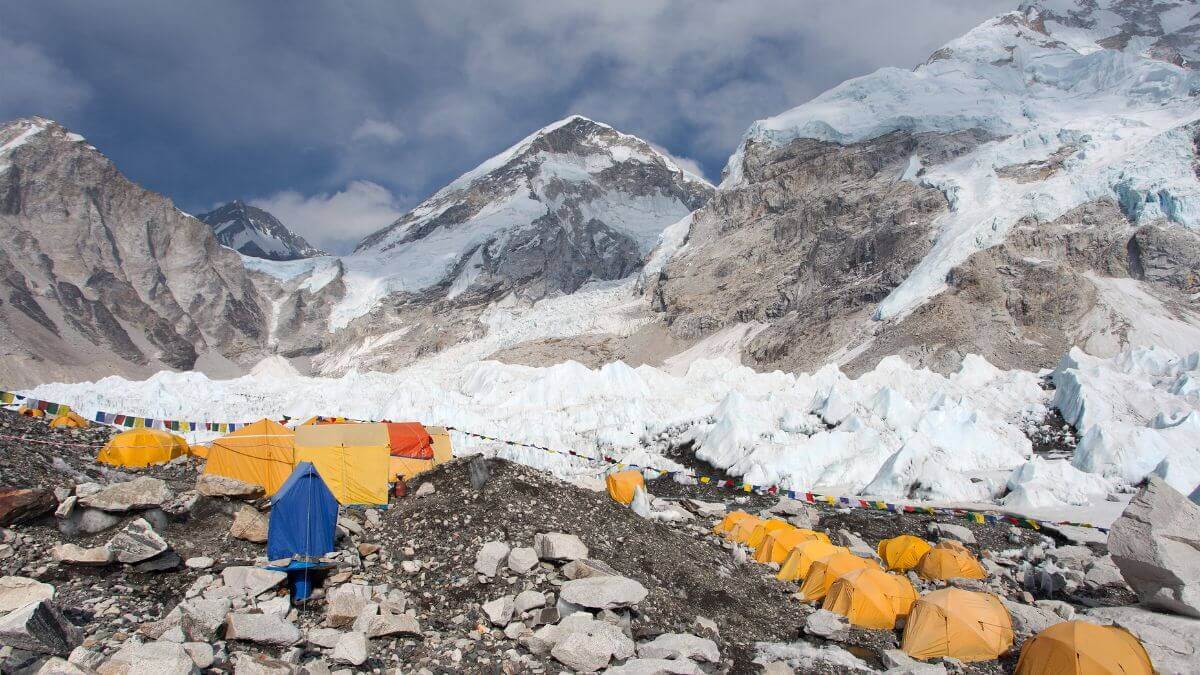
Cultural immersion: Trekkers following the Tibetan-influenced villages reach the Everest Base Camp. Trekkers are welcomed with prayer flags, ancient mani stones, prayer wheels, monasteries, and other sights that provide a glimpse into traditional Sherpa life. The spiritual energy adds depth to the journey.
Feel like it's not enough, check our premium Everest Base Camp Trek for luxurious options.
Everest Base Camp Trekking Difficulty
The Everest base camp trek doesn't require ropes, climbing equipment, or any technical mountaineering skills. The trek is moderately challenging, which demands physical endurance, mental strength, and careful acclimatization. Understanding the difficulty of the Everest Base Camp trek helps trekkers properly prepare and set realistic expectations, ensuring a safe experience. Below is a breakdown of what actually makes the Everest Base Camp Trek difficult:
Long Walking Hours: On a 14-day Everest Base Camp trek or any other itinerary, trekkers often walk 5-7 hours per day. The terrain varies from forest areas and steep stone climbs to rocky sections and glacier paths. The long walk is often challenging on the knees and requires a good level of physical fitness. Beginner trekkers who are not accustomed to long hours of walking may find the trek difficult.
High Altitude and Reduced Oxygen: Trekkers reach an altitude of 5,364 meters while standing at the base camp of Everest. At such a high altitude, the oxygen level drops, making every step feel heavier and more complex. Given the trek's high altitude, trekkers may experience symptoms of Acute Mountain Sickness (AMS). Shortness of breath, fatigue, dizziness, nausea, and headache are common. To counter the effects of AMS, hydration, acclimatization, and a proper diet are essential.
Steep and Rocky Trails: As mentioned, the Everest Base Camp trek comes with a variety of sections. Especially around Tengboche, Dingboche, Lobuche, Gorakshep, and the final stretch to EBC, the trails are steep and rocky. The path consists of uneven stones, glacial fields, and long climbs. Navigation is crucial during this section, and you will require balance, patience, and slow progress.
Cold Temperature: The temperature at Everest Base Camp can drop below freezing point. So, you can expect extreme cold conditions during the final push. Especially the mornings and nights at higher camps like Lobuche and Gorakshep are intense. The weather can change without any warning. So, trekkers need to be aware of the cold. Proper layering and warm gear are essential for the trek.
Basic Tea House Accommodation: Most of the lower regions in the Everest region are well equipped. Places up to Dingboche have electric blankets, heaters, and hot showers, making the walk comfortable. However, the higher-altitude accommodation, especially in Lobuche and Gorakshep, is basic. There are only limited options: unheated rooms, bathrooms outside, and shared, limited hot showers. Trekkers who are not used to such conditions can have difficulty adjusting.
Read our detailed guide on the Everest Base Camp Trek Difficulty to know if the trek is for you.
Everest Base Camp trek cost
- The standard Everest Base Camp trek costs around USD 1,299.
- The 15-Day Everest Base Camp trek cost is around USD 1,399 to 1,499, depending on whether it's a private or group trek.
- The Premium 9-Day Everest Base Camp Trek is a more comfortable package depending on the specific amenities.
- The Everest Base Camp with Helicopter Return package starts from USD 2,799.
What to pack for the Everest Base Camp trek
Here is a short Everest Base Camp trek gear list:
| General |
|
| Upper Body |
|
| Torso |
|
| Lower Body |
|
| Hands |
|
| Feet |
|
| Undergarments & inner wears |
|
| First Aid Kits & Medications |
|
Altitude Sickness and Acclimatization
The highest altitude at Everest Base Camp is 5,364 meters. The signs of altitude sickness are seen at altitudes above 2,400 meters (8,000 feet). There is a risk of altitude sickness during the Everest Base Camp Trek, and to counter its effects, trekkers need to understand the symptoms, causes, complications, and prevention measures.
Signs and Symptoms of Altitude Sickness
- Headache
- Dizziness
- Vomiting
- Fatigue even when resting
- Sleeping trouble
- Nausea
- Blurry vision
Cause of Altitude Sickness
Our bodies can usually adapt to changes in altitude, which affect how much oxygen we get with each breath. However, if we do not give our bodies enough time to adjust, we will get altitude sickness.
Complications of Altitude Sickness
Altitude sickness can be classified into three types. One is the most common form, and the other two can have life-threatening consequences.
- Acute Mountain Sickness (AMS) is the mildest and most common form of altitude sickness.
- High-altitude pulmonary edema (HAPE) is a type of altitude sickness that affects the lungs, leading to fluid accumulation. It is one of the complications of altitude sickness that needs immediate medical attention. Although it is not the most severe form, it can cause death if not treated promptly.
- High-altitude cerebral edema (HACE) is the most severe altitude sickness, causing the brain to swell. It is a hazardous condition that needs immediate emergency care.
Prevention of Altitude Sickness
- Acclimatization: Stopping, resting, and acclimatizing during the trek is one way to reduce the chances of altitude sickness.
- Ascend slowly: Trekkers should not rush while trekking at high altitudes. They must slow their pace and ascend gradually as they adapt to the low oxygen levels at high altitudes.
- Descend: If the symptoms of altitude sickness are severe, trekkers should prioritize descending.
- Supplemental oxygen: Trekkers can carry supplemental oxygen bottles to help alleviate some symptoms of altitude sickness.
How to Stay Safe During the Everest Base Camp Trek
Trekkers need to understand the risks that come with the Everest Base Camp Trek. The high altitude, remote location, and unpredictable weather are among the factors that raise safety concerns during the trek. Here is a detailed guide on how to stay safe during the Everest Base Camp Trek:
Trekking safely in remote areas
Although the Everest Base Camp Trekking Trail is well made, most of the region is remote and lightly populated. Trekkers need to understand the remoteness of the trek, as most of the area offers only limited facilities. It is better to travel with a licensed, native guide. The guide will help in proper navigation and make crucial decisions. Trekkers should stick to marked trails, especially in areas with cliffs, loose rocks, and glacial debris.
Trekkers should also carry a trekking pole for stability, wear proper hiking boots, and avoid rushing. One should also keep a map or a GPS device for appropriate navigation. If any problem arises during the trek, one should inform the guide.
Emergency evacuation
Despite proper planning and safety instructions, trekkers might encounter some emergencies. Emergencies can commonly be due to altitude sickness, injuries, or sudden weather changes—reputable companies like Nepal Trekking Planner Pvt. Ltd has systems in place for emergency evacuation. Helicopter evacuation services from Pheriche, Gorakshep, or Namche Bazaar are available in such emergencies. However, trekkers need to have travel insurance that covers high-altitude trekking and emergency evacuation. It is also better to carry a first-aid kit and other essential tools, such as an Oximeter to monitor oxygen levels. Quick action is vital in case of severe altitude sickness or injury to ultimately save life. Follow your guide's instructions in such cases.
Health precautions
High altitude with low oxygen levels can affect even the fittest trekkers. It is necessary to acclimatize properly and ascend gradually to cope with low oxygen levels. Acclimatization days in Namche and Dingboche are crucial, so trekkers should participate in the acclimatization hikes to help their bodies adapt and prepare for the trek ahead. It is essential to drink plenty of water to stay hydrated, avoid alcohol, and eat nutritious meals to maintain energy levels. All trekkers should be aware of the symptoms of Acute Mountain Sickness and take them seriously. Carry essential medication for headache, diarrhea, dizziness, and loss of appetite. Also, protect yourself from sunburn, dress in layers, and maintain physical fitness for a smooth trekking experience.
Final Thought
The complete guide to the Everest Base Camp trek is essential for trekkers planning to visit the Everest region. It is not just a journey but also a life-changing adventure that pushes human limits. From the rhododendron forest to alpine terrain, the trek provides a splendid opportunity to blend with nature. However, proper preparation is required for the trek. One should be open-minded and should commit to basic facilities during the trek. Even though the trek seems challenging, it is rewarded with one of the breathtaking mountain views available on the planet. So, prepare accordingly, pack suitable gear, listen to your body, and follow your guide's instructions.
A once-in-a-lifetime journey awaits. Contact Nepal Trekking Planner today to start your mountain adventure!
FAQ
1. How long does the trek to Everest Base Camp take?
The Everest Base Camp Trek can be completed in 14 days. However, the trek can be customized to suit your interests. Here is an outline itinerary for the 14-day Everest Trek:
- Day 1: Arrival in Kathmandu and trip preparation, (1,350m/4,429ft), about a 20-25-minute drive from the airport
- Day 2: Take a morning flight from Kathmandu to Lukla (2,860m/9,383ft), 35 min, and trek to Phakding (2,610m/8,560ft), 4-hour trek, walking distance 7.5 km/4.6 miles, and Total Elevation Gain 230 m/ 755 ft
- Day 3: Trek to Namche Bazaar (3,440m/11,287ft) 5-6 hrs. walk, walking Distance: 12 km / 7.45 miles, and Total Elevation Gain 830 m/ 2723 ft
- Day 4: Rest day at Namche Bazaar for acclimatization and local excursion, Hike to Everest View Hotel 3880 m/12730 ft and Total Elevation Gain 440 m/ 1444 ft
- Day 5: Trek to Tengboche (3,850m/12,632ft) 4-5 hrs. walk, walking Distance: 10 km / 6.21 miles, and Total Elevation Gain 420 m/ 1378 ft
- Day 6: Trek to Dingboche (4,350m/14,272ft) 4-5 hrs. walk, walking Distance: 12 km / 7.45 miles and Total Elevation Gain 550 m/ 1805 ft
- Day 7: Rest day at Dingboche for acclimatization and excursion, Hike to Nangkartshang Peak 5083 m/16677 ft and Total Elevation Gain 673 m/ 2208 ft
- Day 8: Trek to Lobuche (4,910m/16,109ft) 4-5 hrs. walk, walking Distance: 12 km / 7.45 miles, and Total Elevation Gain 500 m/ 1640 ft
- Day 9: Trek to Gorakshep (5,180m/16,995ft) 3-4 hrs. walk and Everest Base Camp (5,364m/17,598ft) 2-3 hrs. walk, walking Distance: 15 km / 9.32 miles and Total Elevation Gain 475 m/ 1489 ft
- Day 10: Hike to Kalapatthar (5,545 m/ 18,192 ft.) and continue trekking to Pheriche (4,371 m /14,340 ft), 5-hour trek, walking Distance: 13 km /8.07 miles, and Total Elevation Gain: 415 m + 810 m/ 1362 ft + 2655ft
- Day 11: Trek from Pheriche to Namche Bazaar (3,440 m/11,286 ft) 6-hour trek, walking Distance: 14 km /8.69 miles, and Total Elevation Gain 800 m/2625 ft
- Day 12: Trek from Namche Bazaar to Lukla (2,828m/9,279ft.) 6-hour trek, walking Distance: 21 km /13.0488 miles, and Total Elevation Gain: 612 m/2008 ft
- Day 13: Morning flight from Lukla to Kathmandu
- Day 14: Transfer to the airport and fly back home.
2. How high is Everest Base Camp?
Everest Base Camp is situated at an altitude of 5,364 meters (17,598 feet).
3. Do I need a guide to trek to Everest Base Camp?
No, it is not mandatory to hire a guide for the Everest Base Camp trek; however, it is recommended. Hiring a guide will ensure careful navigation and proper safety. They can ensure the trek is completed safely or help with an emergency evacuation if necessary.
4. Can beginners trek to Everest Base Camp?
Yes, beginners can trek to Everest Base Camp; however, novice trekkers need to prepare physically and mentally before undertaking the trek.
5. What is the cost of trekking to Everest Base Camp?
- The standard Everest Base Camp trek costs around USD 1,299.
- The 15-Day Everest Break costs are around USD 1,399 to 1,499, depending on whether it's a private or group trek.
- The Premium 9-Day Everest Base Camp Trek is a more comfortable package depending on the specific amenities.
- The Everest Base Camp with Helicopter Return package starts from USD 2,799.
6. Do I need a permit to climb Mount Everest?
Yes, you will require a permit to climb Mount Everest, issued by the Ministry of Culture, Tourism, and Civil Aviation of Nepal.




